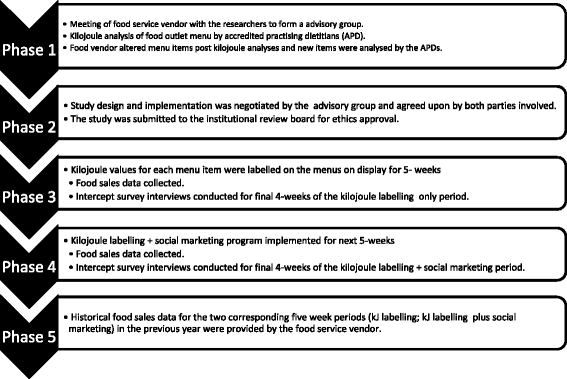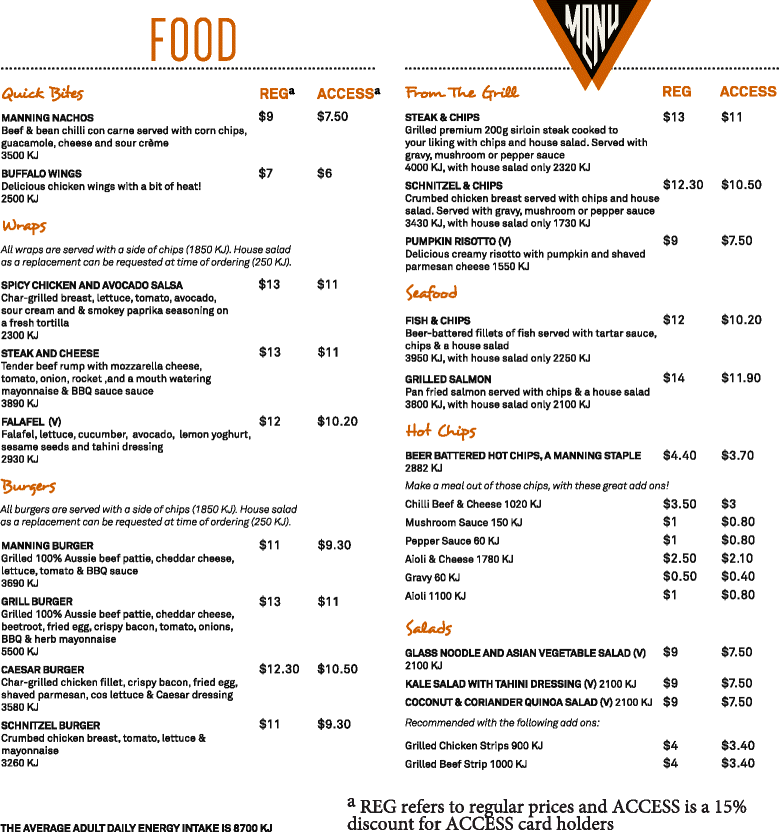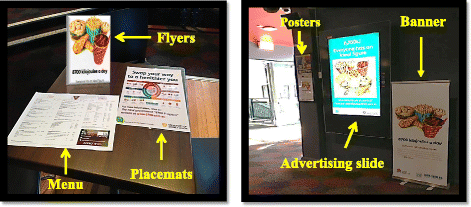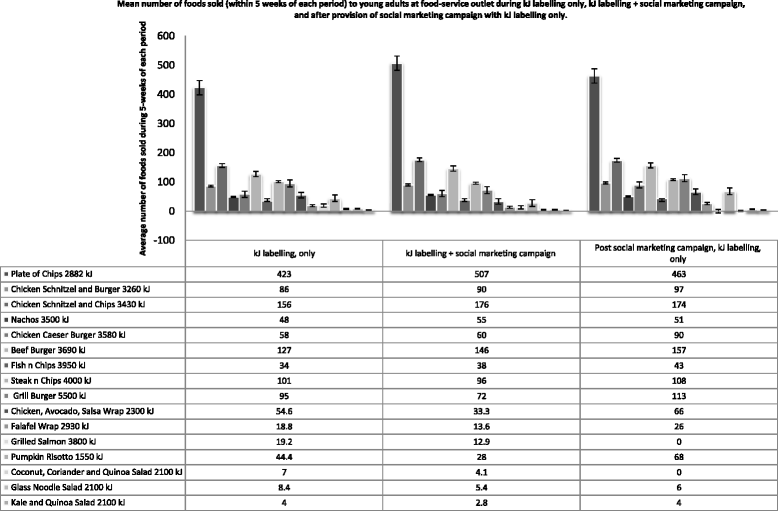The Effect of Energy Labelling on Menus and a Social Marketing Campaign on Food-Purchasing Behaviours of University Students
- PMID: 27496103
- PMCID: PMC4974729
- DOI: 10.1186/s12889-016-3426-x
The Effect of Energy Labelling on Menus and a Social Marketing Campaign on Food-Purchasing Behaviours of University Students
Abstract
Background: This study assessed the impact of kilojoule (kJ) labelling alone or accompanied by a social marketing campaign on food sales and selection of less energy-dense meals by young adults from a university food outlet.
Methods: There were two kJ labelling intervention phases each of five weeks: (1) kJ labelling alone (2) kJ labels with marketing materials ("8700 kJ campaign"). Food sales of labelled items were tracked during each intervention and five weeks after. Food sales during interventions were also compared with historical sales of foods in the same 10-week period in the previous year. A sub sample of young adults (n = 713; aged 19-24) were surveyed during both the interventions to assess awareness, influence, sentiment and anticipated future impact of kJ labels and the social marketing campaign respectively.
Results: There were no differences in sales between the kJ labelling with social marketing and the 5-weeks of labelling before and after. The percentage sale of chicken Caesar burger (3580 kJ, P = 0.01), steak and chips (4000 kJ, P = 0.02) and the grill burger (5500 kJ, P = 0.00) were lower in the year with menu labelling and social marketing campaign. Only 30 % students were initially aware of the kJ labels on the menu but 75 % of students were accepting of kJ labelling, after they were made aware. Respondents viewing the marketing campaign elements and then using kJ values on the menu selected meals with a lower mean energy content; constituting a reduction of 978 kJ (p < 0.01) even though the majority claimed that the 8700 kJ campaign would not impact their food choices.
Conclusions: Point-of-purchase energy labelling may be an effective method to encourage better food choices when eating out among young adults. However, further efforts to increase awareness and provide education about energy requirements to prevent weight gain will be needed.
Keywords: Food choices; Menu labelling; University; Young adults.
Figures




Similar articles
-
Effects of health star labelling on the healthiness of adults' fast food meal selections: An experimental study.Appetite. 2019 May 1;136:146-153. doi: 10.1016/j.appet.2019.01.018. Epub 2019 Jan 23. Appetite. 2019. PMID: 30684644
-
Menu labels displaying the kilocalorie content or the exercise equivalent: effects on energy ordered and consumed in young adults.Am J Health Promot. 2015 May-Jun;29(5):294-302. doi: 10.4278/ajhp.130522-QUAN-267. Epub 2014 Feb 27. Am J Health Promot. 2015. PMID: 24575727 Clinical Trial.
-
What types of nutrition menu labelling lead consumers to select less energy-dense fast food? An experimental study.Appetite. 2013 Aug;67:8-15. doi: 10.1016/j.appet.2013.03.003. Epub 2013 Mar 22. Appetite. 2013. PMID: 23523666
-
Effects of physical activity calorie equivalent food labelling to reduce food selection and consumption: systematic review and meta-analysis of randomised controlled studies.J Epidemiol Community Health. 2020 Mar;74(3):269-275. doi: 10.1136/jech-2019-213216. Epub 2019 Dec 10. J Epidemiol Community Health. 2020. PMID: 31822568
-
Barriers and facilitators to implementation of menu labelling interventions from a food service industry perspective: a mixed methods systematic review.Int J Behav Nutr Phys Act. 2020 Apr 15;17(1):48. doi: 10.1186/s12966-020-00948-1. Int J Behav Nutr Phys Act. 2020. PMID: 32295647 Free PMC article.
Cited by
-
Types of Interventions Targeting Dietary, Physical Activity, and Weight-Related Outcomes among University Students: A Systematic Review of Systematic Reviews.Adv Nutr. 2019 Sep 1;10(5):848-863. doi: 10.1093/advances/nmz027. Adv Nutr. 2019. PMID: 31181143 Free PMC article.
-
Does labelling of healthy foods on menus using symbols promote better choices at the point-of-purchase?Public Health Nutr. 2020 Aug 28;24(4):1-9. doi: 10.1017/S1368980020002840. Online ahead of print. Public Health Nutr. 2020. PMID: 32854800 Free PMC article.
-
Addressing the complex needs of homeless youth with early psychosis and comorbid substance use: a naturalistic longitudinal study of 10 years' experience with EQIIP SOL's specialized outreach service.Soc Psychiatry Psychiatr Epidemiol. 2025 Aug;60(8):1943-1955. doi: 10.1007/s00127-025-02875-7. Epub 2025 Apr 21. Soc Psychiatry Psychiatr Epidemiol. 2025. PMID: 40259034
-
The Role of Supportive Food Environments to Enable Healthier Choices When Eating Meals Prepared Outside the Home: Findings from Focus Groups of 18 to 30-Year-Olds.Nutrients. 2019 Sep 13;11(9):2217. doi: 10.3390/nu11092217. Nutrients. 2019. PMID: 31540273 Free PMC article.
-
How Does the University Food Environment Impact Student Dietary Behaviors? A Systematic Review.Front Nutr. 2022 Apr 8;9:840818. doi: 10.3389/fnut.2022.840818. eCollection 2022. Front Nutr. 2022. PMID: 35571951 Free PMC article.
References
-
- United States Department of Health and Human Services: The Surgeon General’s call to action to prevent and decrease over- weight and obesity. Rockville, MD: Public Health Service, Office of the Surgeon General; 2001.
Publication types
MeSH terms
LinkOut - more resources
Full Text Sources
Other Literature Sources
Medical

